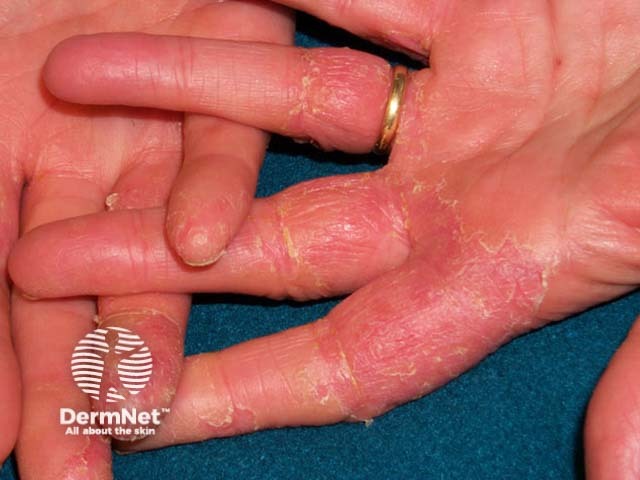Main menu
Common skin conditions

NEWS
Join DermNet PRO
Read more
Quick links
For each of the ten cases, study the image(s) and then answer the questions. You can click on the image to view a larger version if required.
Each case should take approximately 2 minutes to complete. There is a list of suggested further reading material at the end of the quiz.
When you finish the quiz, you can download a certificate.

What is the diagnosis?
Contact dermatitis
What clinical features distinguish this from other hand rashes?
Contact dermatitis is due to an exogenous irritant or allergen and is frequently occupational in origin. It is more common in patients with atopic dermatitis, and to a lesser extent in those with mucosal atopy. The patient generally describes one or more activities that provokes or aggravates the reaction. Taking a break from this activity results in improvement or resolution of the eruption. The skin problem usually affects both hands, although there may be asymmetry in extent or severity, and it rarely affects the feet. Contact dermatitis may involve the palms, the dorsum of the hands or both. It may spread onto the wrists and forearms. The distribution and morphology of the eruption is variable and may include erythema, oedema, vesicles and crusting in the acute phase, and dryness and fissuring in the chronic fissuring. Itch is a prominent feature.
What diagnostic tests are available?
Pain, pustules or crusting suggest secondary infection with Staphylococcus aureus and/or beta haemolytic Streptococcus, and is most likely to complicate dermatitis. Swabs may be appropriate to confirm the presence of bacterial infection and select appropriate antibiotic therapy.
Patch testing is a specialist tool to distinguish contact allergy from the more common irritant contact dermatitis (due to water, detergents, solvents, acids, alkalis and friction). Although some patterns of involvement are suggestive of specific allergy, they are not reliable. Examples include the centre of the palm and flexor aspects of fingers from rubber, nickel or plastic handle grips; the fingertips from formalin in laboratory workers, local anaesthetics in dentists, or garlic and onion in cooks; the flexor aspect of the wrist in lines from the leaves of a plant, such as Primula obconica.
What treatment should be recommended?
Specific treatment depends on the diagnosis and cause of the eruption. In general, dry skin should be protected, lubricated and soothed with emollients. Hand creams should be thick, and a thin amount should be applied frequently. They are not permitted in certain jobs (e.g. car painters), when they should be used liberally after hours. Gloves should be selected according to the required task and worn for short periods to protect the hands from injury; however, contact allergy may arise to rubber, leather, adhesives, and rarely to plastic materials.
As keratinocytes form a thick 'brick wall' in palmar skin, drugs penetrate poorly and the effect of topical steroids may be disappointing compared to other sites of the body. Contact dermatitis can be treated with ultrapotent topical steroids, applied no more than once or twice daily and accurately to the affected area. Typically, the steroid cream (if blistered) or ointment (if dry) is used for about four weeks, and then pulsed at weekends for four to eight weeks. Continued use of ultrapotent topical steroids should be regularly reviewed because of the risk of tachyphylaxis and skin atrophy.
Severe and/or persistent palmar dermatitis interfering with function may require specialist consultation and second line treatments. These may include phototherapy, methotrexate, azathioprine or systemic steroids.